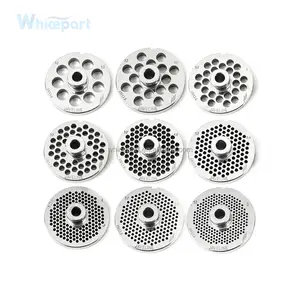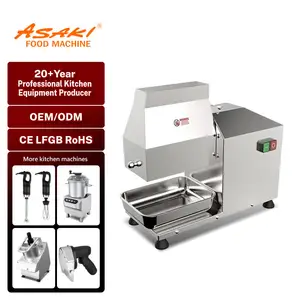Introduction
Welcome to the world of culinary excellence, where even the smallest tools can make a significant difference. One such tool is the stainless steel meat tenderizer, a game-changer in the kitchen that can revolutionize your cooking experience. This article delves into the importance of tenderizing meat, the benefits of choosing stainless steel as the material for your meat tenderizer, and the added advantages of a stainless steel meat tenderizer. We'll also guide you on how to use and maintain this tool, ensuring it remains a staple in your kitchen for years to come.
The Need for a Meat Tenderizer
Tenderizing meat is a crucial step in the cooking process, especially when dealing with tough cuts of steak. The process involves softening the fibers of the meat, making it easier to chew and digest. This is typically achieved using a meat tenderizer, which can be manual or mechanical. The tenderizer works by creating numerous small cuts in the meat, physically severing the connective tissue and making it more tender. This not only enhances the texture of the meat but also aids in the absorption of marinades, adding to the overall flavor of the dish.
Why Choose Stainless Steel?
Stainless steel is a preferred choice for kitchen tools due to its numerous benefits. It's environmentally friendly, being one of the most commonly used green raw materials that's totally recyclable. Stainless steel is known for its amazing strength and durability, resisting rust and corrosion even when scratched. It's also easy to clean and sanitize, making it a safe choice for food preparation. Despite a higher initial cost, stainless steel proves cost-effective in the long run due to its longevity. These qualities make stainless steel an excellent material for a meat tenderizer.
Benefits of a Stainless Steel Meat Tenderizer
A stainless steel meat tenderizer is an essential tool for preparing dishes like carpaccio and saltimbocca. Its circular beating surface ensures even tenderizing, resulting in uniformly thin and tender meat. The stainless steel construction not only lends it a simple, elegant beauty but also ensures durability and hygiene. The glossy polish of the mirror-like surface is easy to clean, maintaining its hygienic properties. This heavy-duty tool, made in Lombardy, is worth its price for the quality of material and craftsmanship involved.
Durability and Longevity
Stainless steel is a popular choice for kitchen tools, including meat tenderizers, due to its durability and longevity. The KitchenAid meat tenderizer, for instance, is made with steel, making it long-lasting and reliable. Similarly, the Gourmet Easy meat tenderizer, also made of stainless steel, is praised for its durability. These tools are designed to withstand frequent use, ensuring they remain a staple in your kitchen for years to come.
Ease of Cleaning and Maintenance
The Hobart 403 meat tenderizer, made of stainless steel, is designed for easy cleaning and maintenance. The guard, knife cluster, and strip cutter are removable, allowing for thorough cleaning. These parts can be cleaned in a three-compartment sink, sanitized with an iodine-based solution, and rinsed thoroughly. The exterior of the machine can be wiped down with a clean, wet cloth. The machine and parts should be allowed to air dry completely before reassembly. Regular cleaning prevents cross-contamination when changing types of meat.
Enhanced Cooking Experience
The use of a meat tenderizer can significantly enhance your cooking experience. As discussed in the original content, tenderizing meat is a crucial step in achieving a desirable texture and flavor. The mechanical method of tenderization, which involves pounding or piercing the meat, can be easily achieved with a stainless steel meat tenderizer. This method pre-chews the meat for you, breaking up the connective tissues and meat fibers. While it's not ideal for grilling, it's perfect for dishes requiring thin and tender meat. Thus, a stainless steel meat tenderizer can be a valuable tool in your kitchen.
How to Use a Stainless Steel Meat Tenderizer
Using the JY COOKMENT stainless steel meat tenderizer is straightforward. First, ensure it's thoroughly cleaned before the initial use. Place your meat on a cutting board and remove the protective cover from the tenderizer. Gently press the tenderizer on the meat's surface, pushing it into the meat several times, avoiding any bones. After each use, clean the tenderizer by soaking it in warm soapy water for a few minutes, then wash it. It's also dishwasher safe. Remember, the blades are sharp, so keep it out of children's reach and avoid using it on bones or frozen meat to prevent damage.
Choosing the Right Stainless Steel Meat Tenderizer
When choosing a stainless steel meat tenderizer, consider its design and functionality. A mallet-style pounder is versatile, ideal for tenderizing meats and other kitchen tasks. Look for a heavier mallet head and a lighter handle for a powerful swing that requires less effort. The pounding surface should be small for targeted action, but not so small that it becomes ineffective. Mallets with rounded edges are less likely to tear the meat. Handles with silicone coverings are comfortable and ensure an easy grip. If you need a bladed tenderizer, it should be durable, sharp, and made with high-quality, rust-resistant materials. More blades mean more tender meat in less time, but they should be adequately spaced for even tenderizing. Models that are easy to clean or dishwasher-safe are advantageous.
Tips for Maintaining Your Stainless Steel Meat Tenderizer
Maintaining your stainless steel meat tenderizer is crucial for its longevity and performance. It's easy to clean and dishwasher safe, but remember to handle with care due to its sharp blades. For manual cleaning, follow the manufacturer's instructions. Regular cleaning prevents residue build-up and keeps the blades sharp. The product comes with a one-year warranty covering defects due to faulty material or workmanship, but it doesn't cover normal wear and tear, damage through misuse, or unauthorized alterations. To extend the warranty, register your product on the manufacturer's website.
Conclusion
In conclusion, a stainless steel meat tenderizer is an indispensable tool in any kitchen. Its role in enhancing the texture and flavor of meat, coupled with the durability, hygiene, and ease of maintenance that stainless steel offers, makes it a worthy investment. Whether you're a professional chef or a home cook, this tool can significantly improve your cooking experience. Choosing the right tenderizer and maintaining it properly will ensure its longevity and performance. So, embrace the magic of a stainless steel meat tenderizer and revolutionize your kitchen today.






































 浙公网安备 33010002000092号
浙公网安备 33010002000092号 浙B2-20120091-4
浙B2-20120091-4